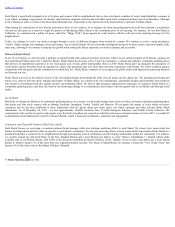Shake Shack 2016 Annual Report Download - page 21
Download and view the complete annual report
Please find page 21 of the 2016 Shake Shack annual report below. You can navigate through the pages in the report by either clicking on the pages listed below, or by using the keyword search tool below to find specific information within the annual report.
Table of Contents
▪ failure of the landlords to timely deliver real estate to us and other landlord delays;
▪ the proximity of potential sites to an existing Shack, and the impact of cannibalization on future growth;
▪ anticipated commercial, residential and infrastructure development near our new Shacks; and
▪ the cost and availability of capital to fund construction costs and pre-opening costs.
Accordingly, we cannot assure you that we will be able to successfully expand as we may not correctly analyze the suitability of a location or anticipate all of the
challenges imposed by expanding our operations. Our growth strategy, and the substantial investment associated with the development of each new company-
operated Shack, may cause our operating results to fluctuate and be unpredictable or adversely affect our profits. In addition, as has happened when other
restaurant concepts have tried to expand, we may find that our concept has limited appeal in new markets or we may experience a decline in the popularity of our
concept in the markets in which we operate. If we are unable to expand in existing markets or penetrate new markets, our ability to increase our revenues and
profitability may be materially harmed or we may face losses.
Our expansion into new domestic markets may present increased risks, which could affect our profitability.
We plan to open domestic company-operated Shacks in markets where we have little or no operating experience. Shacks we open in new markets may take longer
to reach expected Shack sales and profit levels on a consistent basis, are likely to be less profitable on average than our current base of Shacks and may have higher
construction, occupancy or operating costs than Shacks we open in existing markets. New markets may have competitive conditions, consumer tastes and
discretionary spending patterns that are more difficult to predict or satisfy than our existing markets. We may need to make greater investments than we originally
planned in advertising and promotional activity in new markets to build brand awareness. We may find it more difficult in new markets to hire, motivate and keep
qualified employees who share our values. We may also incur higher costs from entering new markets if, for example, we assign area directors to manage
comparatively fewer Shacks than we assign in more developed markets. Also, until we attain a critical mass in a market, the Shacks we do open will incur higher
food distribution costs and reduced operating leverage. As a result, these new Shacks may be less successful or may achieve target Shack-level operating profit
margins at a slower rate, if ever. If we do not successfully execute our plans to enter new markets, our business, financial condition or results of operations could
be adversely affected. In addition, we plan to continue to expand into new international markets, which can pose similar and additional challenges in opening new
Shacks.
New Shacks, once opened, may not be profitable, and may negatively affect Shack sales at our existing Shacks.
Our results have been, and in the future may continue to be, significantly impacted by the timing of new Shack openings (often dictated by factors outside of our
control), including landlord delays, associated Shack pre-opening costs and operating inefficiencies, as well as changes in our geographic concentration due to the
opening of new Shacks. We typically incur the most significant portion of pre-opening costs associated with a given Shack within the three months preceding the
opening of the Shack. Our experience has been that labor and operating costs associated with a newly opened Shack for the first several months of operation are
materially greater than what can be expected after that time, both in aggregate dollars and as a percentage of Shack sales. Our new Shacks commonly take eight to
12 weeks to reach target operating levels due to inefficiencies typically associated with new Shacks, including the training of new personnel, new market learning
curves, inability to hire sufficient qualified staff and other factors. We may incur additional costs in new markets, particularly for transportation and distribution,
which may impact the profitability of those Shacks. Although we have specific target operating and financial metrics, new Shacks may not meet these targets or
may take longer than anticipated to do so. Any new Shacks we open may not be profitable or achieve operating results similar to those of our existing Shacks,
which could adversely affect our business, financial condition or results of operations.
The opening of a new Shack in or near markets in which we already have Shacks could adversely affect the Shack sales of those existing Shacks. Existing Shacks
could also make it more difficult to build our consumer base for a new Shack in the same market. We will continue to cluster in select markets and open new
Shacks in and around areas of existing Shacks that are operating at or near capacity to leverage operational efficiencies and effectively serve our guests.
Cannibalization of Shack sales among our Shacks may become significant in the future as we continue to expand our operations and could adversely affect our
Shack sales growth, which could, in turn, adversely affect our business, financial condition or results of operations.
Additionally, many of our current domestic company-operated Shacks are located in urban markets. As we expand, this percentage will decline and as a result we
may not be able to maintain our current average unit volumes ("AUVs") and Shack-level operating profit margins and our business, financial condition and results
of operations may be adversely affected.
19 | Shake Shack Inc. Form 10-K
























